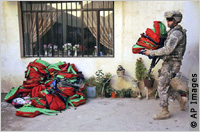PEACE & SECURITY | Creating a more stable world
06 November 2008
Some American Forces Leave Iraq Ahead of Schedule
Expedited troop reduction made possible by improving security conditions

Washington — Dramatic security progress in Iraq will allow the U.S. military to reduce troop levels faster than expected, says White House spokeswoman Dana Perino, who announced that approximately 3,500 American soldiers will return to their home base nearly two months ahead of schedule.
“Iraqi security forces are growing in strength and numbers and competence and confidence every day,” Perino told reporters November 6. “Because of those continued improvements that have been proceeding at a very steady pace, violence is way down.”
In a September 9 speech, President Bush announced that the United States planned to reduce its contingent in the 18-nation Multinational Force — Iraq coalition from 15 combat brigades to 14, based on recommendations from U.S. Ambassador Ryan Crocker and U.S. Army General David Petraeus, then the top military commander in Iraq. The 101st Airborne Division’s 3rd Brigade was scheduled to leave in November 2008, with the division’s 2nd Brigade following by early February 2009. Only one of the two units would be replaced, while a third brigade from the Army’s 10th Mountain Division previously intended for Iraq would be deployed to Afghanistan.
In all, nearly 8,000 troops would leave Iraq by February 2009 under what Bush called a policy of “return on success.” (See “United States Withdrawing 8,000 Troops from Iraq by February.”)
Under the new withdrawal plan, the 2nd Brigade will return to Fort Campbell, Kentucky, in November — six weeks ahead of schedule. The unit is currently serving in northwest Baghdad, which has seen a 50 percent decline in violent activity in the wake of the successful 2007–2008 “surge” that temporarily raised U.S. troop levels from 15 combat brigades to 20.
The additional forces — approximately 30,000 soldiers and Marines — helped Iraqis take back their country from extremists and set the stage for political reform and continued progress on reconstruction and economic development. (See “Surge Puts Iraq Back on Track, Says Bush.”)
Petraeus, who was recently promoted from coalition commander to the helm of the U.S. military’s Central Command, decided on the accelerated withdrawal based on recommendations from U.S. Army General Ray Odierno, his successor and former deputy commander in Iraq, who helped oversee the surge. The last of the U.S. surge brigades left Iraq in July — a 25 percent reduction of U.S. forces.
In October, coalition forces faced the fewest “security incidents” since January 2004, Pentagon spokesman Geoff Morrell told journalists November 5, while U.S. combat casualties during the month were among the lowest since the start of the conflict in 2003. “The hope is they can come home before Christmas,” Morrell said.
The announcement follows the October 29 transfer of security responsibilities in Iraq’s southern province of Wasit from coalition to civilian authorities. The transfer follows the return of nearby Babil province and makes Wasit the 13th of Iraq’s 18 provinces to return to full Iraqi government control.
